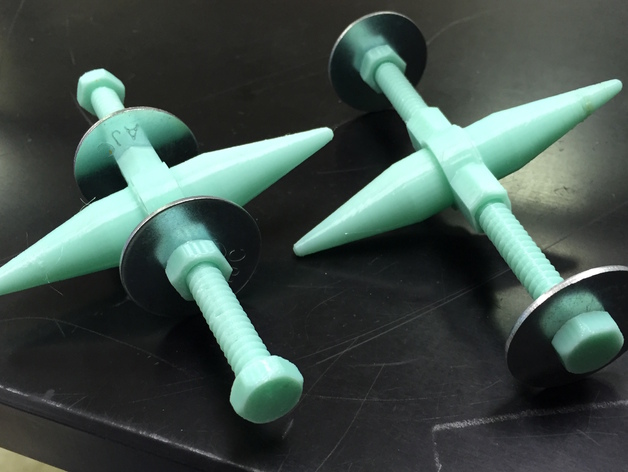
Rotational Energy Lab
thingiverse
I crafted this device to explore rotational energy and moment of inertia. I simply adapted my CD Acceleration lab, adding Nuts and Bolts to its sides, which allows me to utilize fender washers as adjustable weights. The washers can be positioned at varying distances from the center of rotation to alter the moment of inertia or additional washers can be added to vary the mass. This apparatus offers numerous investigations that students can conduct. Print Settings Printer Brand: MakerBot Printer: MakerBot Replicator Rafts: No Supports: No Notes: For the main part and nuts, I printed with two perimeters and 10% infill. Printing bolts with these settings will likely result in breakage. Instead, I printed the bolts with three perimeters and 50% infill. Post-Printing You'll need fender washers as weights. Place an equal number on each bolt. Using a nut or two will enable you to hold them in place at different distances from the center of the circle. The "track" consists of a pair of steel electrical conduit pipes held by bricks and angled to form a ramp. If the angle is too steep, the device may slide rather than roll. You can mitigate this by applying a coat of plastic-dip to the cones. How I Designed This I assembled this in Tinkercad by combining my CD Acceleration Lab with parts created using Mike Linus' Nut Job. I had to tweak my CD Acceleration apparatus slightly so that the bolts would be centered on the assembled device. Standards NGSS Overview and Background This activity is intended for students who have prior experience with conservation of energy and rotation. Students will learn how they can experimentally determine the Moment of Inertia. This activity is designed as one of the final activities during the unit on rotational motion. Objectives Students will be able to calculate the rotational energy of an object by applying conservation of energy. Students will be able to determine the Moment of Inertia for a non-standard object. Audiences High school physics students College physics students Subjects Rotational Dynamics Conservation of energy Skills/Standards NGSS Scientific and Engineering Practices Planning and carrying out investigations Developing and using models Analyzing and interpreting data Using mathematical and computational thinking NGSS Crosscutting Concepts Scale, proportion, and quantity Energy and Matter NGSS Core Ideas: PS2.A: Forces and Motion PS3.A: Definitions of Energy PS3.B: Conservation of Energy and Energy Transfer Lesson Plan and Activity Show the rotational motion apparatus rolling down the rails. The rails are electrical conduit held by bricks with homes in them. One end is elevated. Alternatively, you could use a pair of dynamics tracks laid on their sides. Ask students to determine the Moment of Inertia of the object. Allow no more than 20 minutes for this task. Give students no instructions other than showing the apparatus rolling down the rails. Students should devise their own methodology for determining the Moment of Inertia. Circulate and monitor students as they progress, asking questions to draw their attention to similarities between this and previous labs as needed. When done, have students put their work on large whiteboards to share in whole class discussion. They should also photograph their whiteboard with their phone and email it to the teacher before the discussion. Duration This activity should only take a single class period Materials Needed You will need the following for each group of three students: Pair of bricks with holes Pair of electrical conduit Rotational energy apparatus Pair of fender washers Hudl Technique app on cell phone It is assumed that students have used the Hudl Technique App in previous labs. Meter sticks should be available.
With this file you will be able to print Rotational Energy Lab with your 3D printer. Click on the button and save the file on your computer to work, edit or customize your design. You can also find more 3D designs for printers on Rotational Energy Lab.
